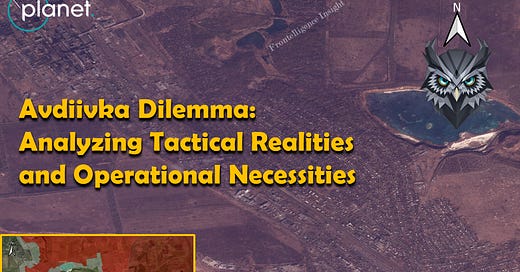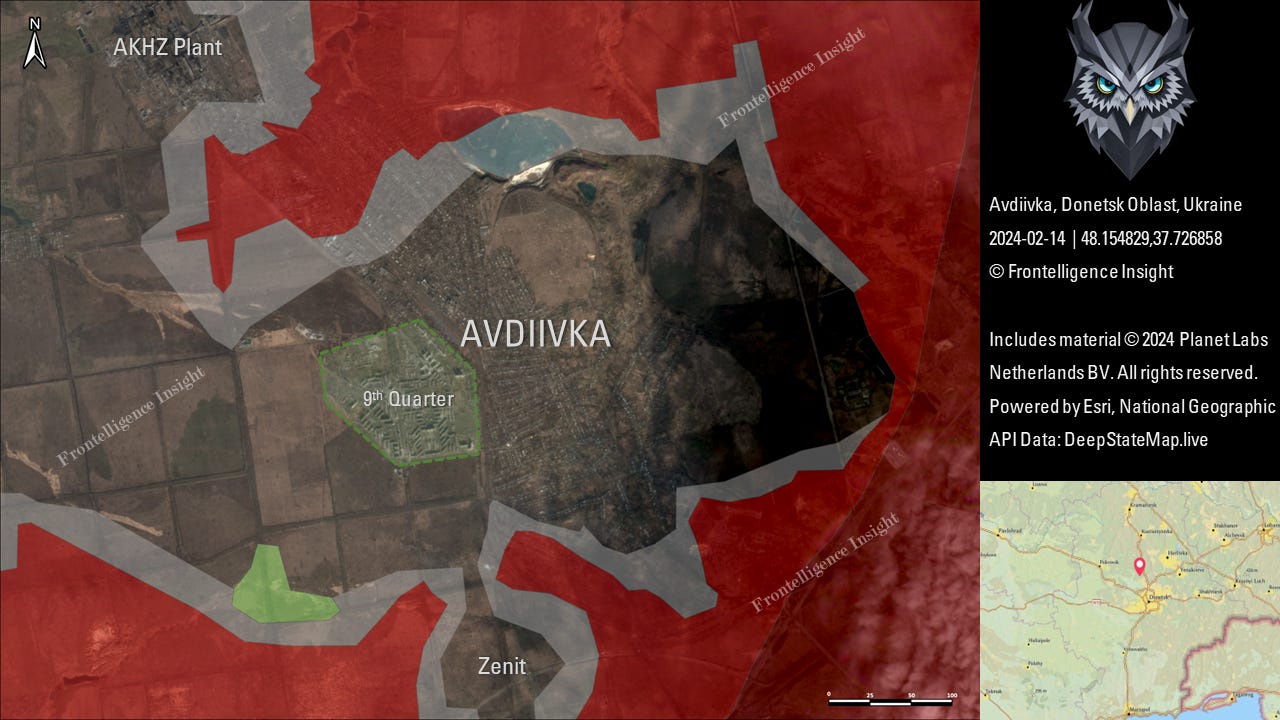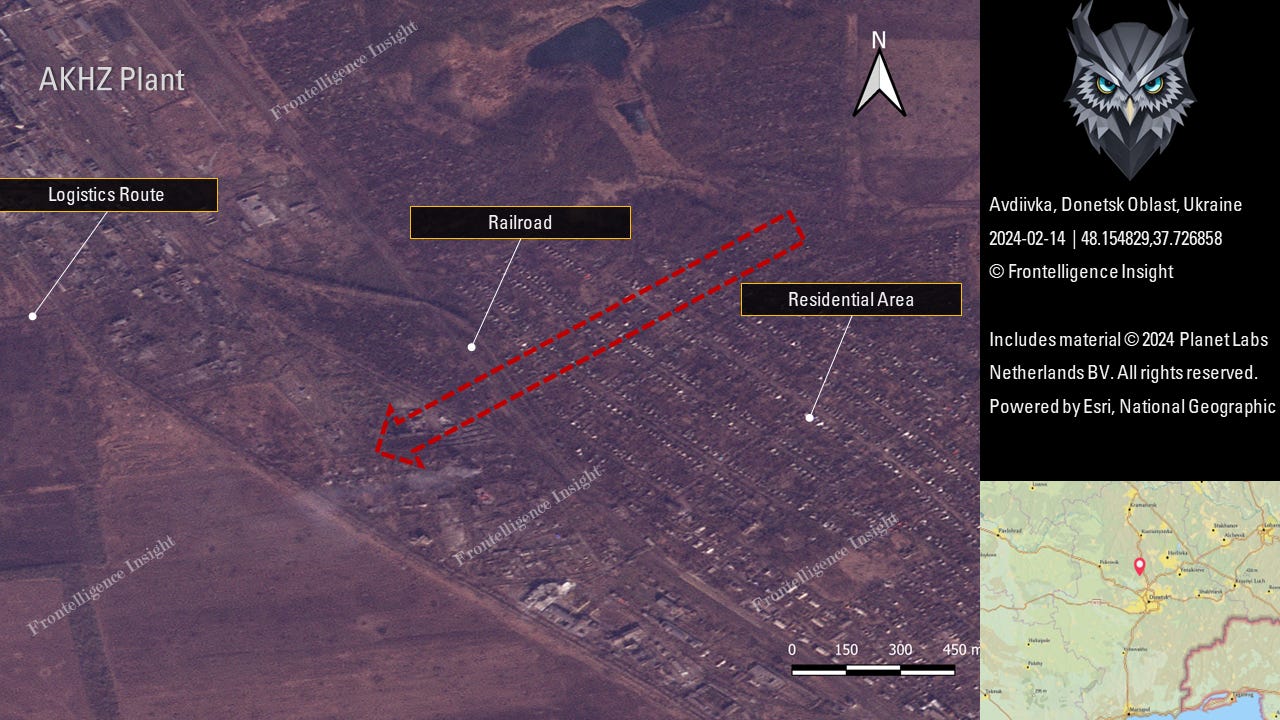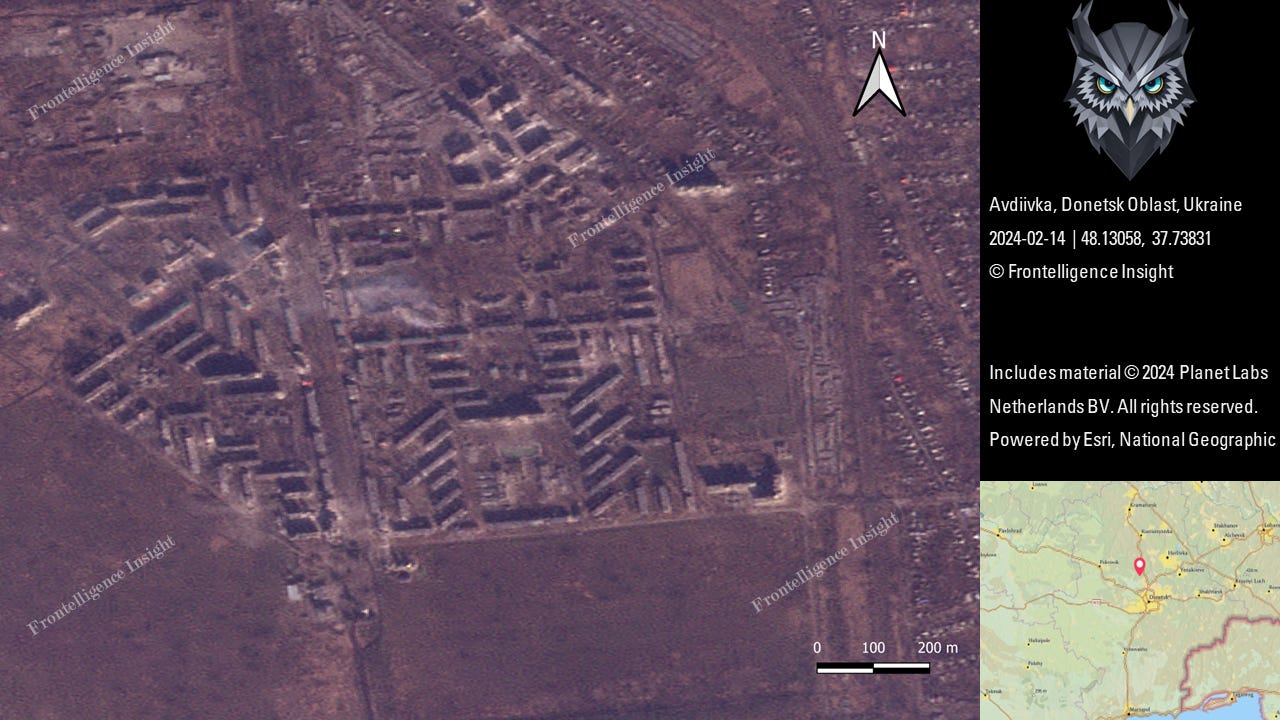Avdiivka Dilemma: Analyzing Tactical Realities and Operational Necessities
February 14th 2024 Update.
On February 7th, 2024, we were among the first to report that the fall of Avdiivka seemed inevitable. Since then, the situation has deteriorated further, with Russian forces advancing deeper. In response, Ukraine deployed its elite 3rd Separate Assault Brigade to the area to assist with the situation. However, the critical situation in Avdiivka persists and certain units face the imminent threat of being encircled or cut off from crucial logistics routes. By leveraging satellite imagery, sources on the ground, and OSINT resources, we would like to offer you insights into the dynamically evolving battlefield.
Key Observations in Avdiivka (2024-02-14):
Russian forces possess a significant numerical advantage in both personnel and vehicles. During the initial assault, as Russians advanced toward well-fortified Ukrainian positions across open, frequently mined fields, with tree lines providing the only natural protection, they sustained disproportionately higher losses in vehicles and personnel than the defenders of Avdiivka. The high casualty rate was a result of several errors and unrealistic expectations during the initial phase. For instance, a platoon from the 15th Separate Guards Motorized Rifle Brigade was assigned the task of penetrating three kilometers deep into Ukrainian defenses on the first day of the assault. However, in reality, the brigade lost approximately 40 BTRs (Armored Personnel Carriers) between October 10th and 19th. Concurrently, after sustaining considerable casualties, Russian brigades like the 15th, 21st, and 114 decided against involving additional troops. They chose not to deploy extra battalions from these brigades, abandoning the notion of quickly surrounding Avdiivka with mechanized forces.
The situation for the Russians improved upon entering the city. Around the 21st of January, they began infiltrating the residential areas of Avdiivka. Leveraging underground communications, the Russians, with an element of surprise, successfully took control of several rear positions held by Ukrainian troops in Avdiivka. This flexible approach compelled defenders to retreat, ultimately enabling the Russians to establish a foothold in Avdiivka. Casualty ratios tend to equalize once the enemy enters urban areas, especially if they have artillery and air support, allowing them to progress street by street while severing supply routes.
Initially, Russian assaults, aiming at a large pincer movement along with mechanized and infantry attacks, faced significant setbacks. This was largely attributed to the underestimation of the determination of Ukrainian troops to defend their positions and an overestimation of the strength of Russian forces in the northern flank. Despite continuous pressure on the Northern and Southern areas between October and December, the inability to complete the encirclement led the Russians to shift their focus inside Avdiivka itself. Thanks to partial air superiority, Russian forces conducted multiple airstrikes with guided aerial bombs. The lack of ammunition for counter-battery fire allowed Russians to deploy large numbers of artillery that weakened Ukrainian defenses. After identifying weak spots, multiple groupings moved in converging directions to achieve envelopment.
Russian troops incurred high casualties by any standard, which is evidenced by the necessity for the 25th Combined Arms Army to transfer its equipment to the 2nd and 41st Combined Arms Armies to sustain ongoing assaults. However, contrary to a myth, Russian forces didn’t perform constant frontal assaults. The enemy has adapted to become more creative and flexible. Realizing the limitations of overpowering positions with powerful mechanized strikes, they started to separate Ukrainian forces into smaller pockets and divided them across distinct sectors. Instead of a direct push in Stepove, an area the enemy struggled to control, as predicted by our team months ago, they identified a weak spot in the northeast of Avdiivka. Here, they pushed to expand their zone of control to the railroad and beyond.
The target area of KAB (airdropped guided bomb) hits has expanded. Russian aerial bombs are not limited to Avdiivka but have extended to nearby villages in rear areas, including Ocheretyne, Novoselivka Persha, and Novobakhmutivka.
Several reports from various units that managed to capture prisoners of war indicate that recruits were enlisted in December and January. Information that we have reveals that a group of ~10 prisoners was recruited in mid-January. While these soldiers might lack experience, the influx of recruits ensures non-stop pressure on exhausted Ukrainian units, draining their resources and forcing them to retreat.
According to various estimates, between 37-42 KAB bombs were dropped on Avdiivka in a single day this week. Despite their inaccuracy, these highly destructive bombs cause extensive damage due to their explosive load, leading to the damage or destruction of nearby buildings. In the imagery captured on February 14th, it is evident that numerous buildings have sustained significant damage
With Russians nearing the creation of multiple pockets in the city, limited options remain—either withdraw from enveloped positions or attempt to break the encirclement through a counter-attack. However, organizing a successful counter-attack is extremely challenging in such an environment, given the amassed Russian forces, including the elements of the Guards Tank division, Ukraine would need to concentrate forces in a narrow strip of land for a frontal or flank counter-attack without the advantage of artillery or air support.
What’s next?
The most logical course of action at this point would likely be a withdrawal and evacuation from Avdiivka. While this may be viewed unfavorably from a political perspective, the initial months of defending Avdiivka inflicted substantial damage on the Russian military, preventing them from advancing deep into Ukrainian territory as originally planned. The Russians failed to achieve a breakthrough, rapidly encircle Avdiivka, and access the operational space to strike Ukrainian rears and logistic routes supplying other forces across Donetsk oblasts. Instead, as of February 9, 2024, more than 655 vehicles suffered varying levels of damage or were destroyed, captured, and abandoned on the outskirts of Avdiivka, as reported by OSINT analyst Naalsio, known for meticulously recording geolocated and video-confirmed losses. Between October 10th and November 28th, our team has identified and reported more than 211 damaged or abandoned Russian vehicles near Avdiivka.
This provided an opportunity for Ukraine to fortify and strengthen areas beyond Avdiivka, albeit the construction of fortifications is still incomplete. Avdiivka is Ukraine's last gateway to Donetsk—a potential foothold for offensive operations to liberate the city. Despite the theoretical promise, this prospect is becoming increasingly unrealistic in light of the current frontline situation.
During this highly dynamic environment, the trajectory of the battle suggests an inevitable withdrawal of Ukrainian forces and the imminent fall of important defense positions such as Zenit. Barring any unexpected events, this chapter is likely to conclude soon.











Thank you for this valuable information.
You guys are doing a great job. Thanks for the info.